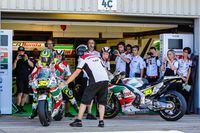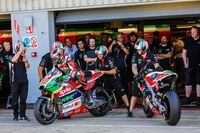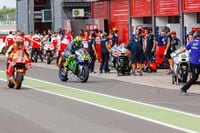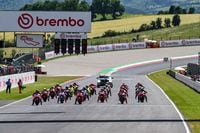A new flag-to-flag procedure for swapping bikes during changing weather conditions was tested this afternoon at Silverstone during the FP2 practice. Although the riders had initially rejected the new flag-to-flag procedure idea that was suggested by the teams back in Austria, today it was tried at the end of the second free practice session by all the teams. If the new procedure ends up being approved by the riders—who will be discussing it in their Safety Commission meeting later on this weekend—it will mean a big change in the actual procedure, as it will eliminate most of the mechanics that currently clog up the pit lane during flag-to-flag bike swaps.
The new procedure has markers set in pitlane designating where each team’s pitbox is located, so that the rider knows where to turn in. The outgoing bike set at a 40º angle to the front of the pitbox pointing to the pit lane exit. The incoming bike will head towards the box entrance in an approximate opposite angle of 40º to the pitbox entrance, stopping on a red box designation on the pavement in front of the garage. The rider would then swap bikes and the angle of the outgoing bike gives the rider a better position to see if the path is clear (although a “lollipop” mechanic—so-named because of the small hand-held sign he must use to signal the rider—still has the final say in when it is safe to leave). With this system the pit lane would be free of mechanics, needing just three: one very close to the box exit to hold the outgoing bike, plus the lollipop mechanic, and one more to catch the incoming bike. The incoming bike could be immediately pushed inside the garage, instead of staying in the pit lane until the team mechanics can wait until the traffic clears as normally happens with the procedure used until now.
This system was rejected by the riders in their Safety Commission in Austria two weeks ago, but the teams have forced them to try it. “I have to say that for the moment I am against it”, said Marc Marquez when asked yesterday; ironically, he wasn’t able to try the new procedure during FP2 today because of his crash. Most of the reasons given by some riders for rejecting it are fairly valid; the biggest fear is centered around the angle of the incoming bike to the pitbox. Many riders stated that if a rider were to lose control of the bike heading into the pitbox (as could be imagined if it began to rain, and a rider was coming in fast on slicks with carbon brakes on wet pavement) that the bike would end up sliding directly into the pitbox and possibly injuring a number of people in the garage.
Regardless, MotoGP rightsholders Dorna and the teams want some sort of a solution to the issue that nearly resulted in terrible injury in pitlane at Brno in the Czech Republic.



/cloudfront-us-east-1.images.arcpublishing.com/octane/ZBLIY3XNQ5ACNNJ65IL44KBZAE.jpg)
/cloudfront-us-east-1.images.arcpublishing.com/octane/HDO56KGQB5H25DJRM2J2PH2E5A.jpg)
/cloudfront-us-east-1.images.arcpublishing.com/octane/NZKPFUWBHVGYJAFQPCXWAK6BZM.jpg)
/cloudfront-us-east-1.images.arcpublishing.com/octane/K5ZSQFMYQZHWRFXTTW4PEWMUDM.jpg)
/cloudfront-us-east-1.images.arcpublishing.com/octane/D2SOSBIQQRBPTERNSOJRAW3KYY.jpg)
/cloudfront-us-east-1.images.arcpublishing.com/octane/DS3Q5X2VJFFAJDK2PWB3Y7K6U4.jpg)
/cloudfront-us-east-1.images.arcpublishing.com/octane/4KBL4JAMYRFDPEINTWATDUH7OM.jpg)
/cloudfront-us-east-1.images.arcpublishing.com/octane/FXADK3MVSNBRTKJ2B7TPDCCJ5Y.jpg)
/cloudfront-us-east-1.images.arcpublishing.com/octane/M7L2CPXO55FRFMECW7QGDPGP6E.jpg)
/cloudfront-us-east-1.images.arcpublishing.com/octane/T4RWGLAEHVE2VCJZOTFTNGB2KA.jpg)
/cloudfront-us-east-1.images.arcpublishing.com/octane/JM4QGLAHWNGHPM74OEB7FVBFSY.jpg)
/cloudfront-us-east-1.images.arcpublishing.com/octane/BGPNXPDDYBHD3HL6YEZQOYHXTI.jpg)
/cloudfront-us-east-1.images.arcpublishing.com/octane/SND5GGQV4RDPPMZBSBEGIZ4SIY.jpg)
/cloudfront-us-east-1.images.arcpublishing.com/octane/XUDDAPYZMZEL5EDPVDJ2DTULWI.jpg)
/cloudfront-us-east-1.images.arcpublishing.com/octane/M7AU2L6GAVCJVHW57LIRPDAAUQ.jpg)

/cloudfront-us-east-1.images.arcpublishing.com/octane/JKEJY7P43JGD5C5NJO2VJQJPUM.jpg)
/cloudfront-us-east-1.images.arcpublishing.com/octane/YROKYJYUQVGPHCEMPTGBWDQCKQ.jpg)
/cloudfront-us-east-1.images.arcpublishing.com/octane/QIHEYR66TZDAPCGMWHCWCBC4XA.jpg)
/cloudfront-us-east-1.images.arcpublishing.com/octane/4FTBMNZL5BD2ZHY62XXRHJW6PI.jpg)
/cloudfront-us-east-1.images.arcpublishing.com/octane/L2BHKRCEMFDF7O3S4REZXPDH2E.jpg)
/cloudfront-us-east-1.images.arcpublishing.com/octane/QHENIV3HMJCTTCXQ6O5YPTNRZ4.jpg)
/cloudfront-us-east-1.images.arcpublishing.com/octane/K3VNQBIAKVGIHIGBRG7QKJYLVI.jpg)
/cloudfront-us-east-1.images.arcpublishing.com/octane/HRU64QXT3NH2DJOFBVI53XIKCE.jpg)